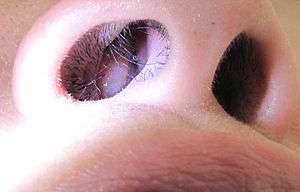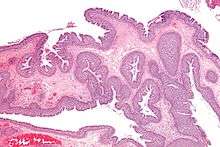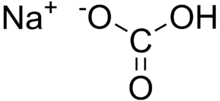Nasal polyp
| Nasal polyps | |
|---|---|
 | |
| A nasal polyp | |
| Classification and external resources | |
| Specialty | Otorhinolaryngology |
| ICD-10 | J33 |
| ICD-9-CM | 471 |
| MedlinePlus | 001641 |
| eMedicine | ent/334 ent/335 |
| MeSH | C09.603.557 |
Nasal polyps (NP) are non cancerous growths within the nose or sinuses.[1] Symptoms include trouble breathing through the nose, loss of smell, decreased taste, post nasal drip, and a runny nose. The growths are sac-like, movable, and nontender. They typically occur in both nostrils in those who are affected. Face pain may occasionally occur.[1] Complications may include sinusitis.[2]
The exact cause is unclear. They occur more commonly among people who have allergies, cystic fibrosis, aspirin sensitivity, or certain infections. They are overgrowths of the mucous membranes. Diagnosis may occur by looking up the nose and a CT scan may be used to help plan treatment.[1]
Treatment is typically with steroids, often in the form of a nasal spray. If this is not effective surgery may be considered. The condition may recur following surgery. Antihistamines may help with symptoms but do not change the underlying disease. Antibiotics are not required unless complications occur. About 4% of people currently have nasal polyps while up to 40% of people develop them at some point in their life. They most often occur after the age of 20 and are more frequent in males than females.[1]
Signs and symptoms
Nasal polyps are usually classified into antrochoanal polyps and ethmoidal polyps. Antrochoanal polyps arise from the maxillary sinuses and are the much less common;[3] ethmoidal polyps arise from the ethmoidal sinuses.[4]
Symptoms of polyps include nasal congestion, sinusitis, anosmia (loss of smell), and secondary infection leading to headache. They may be removed by surgery, but are found to recur in about 70% of cases. Sinus surgery requires a great amount of precision as this involves risk of damage to orbit matter.[5]
Causes

The pathogenesis of nasal polyps is unknown. Nasal polyps are most commonly thought to be caused by allergy and rarely by cystic fibrosis although a significant number are associated with non-allergic adult asthma or no respiratory or allergic trigger that can be demonstrated. Nasal mucosa, particularly in the region of middle meatus becomes oedematous due to collection of extracellular fluid causing polypoidal change. Polyps which are sessile in the beginning become pedunculated due to gravity and excessive sneezing.[6]
In early stages, surface of nasal polyp is covered by ciliated columnar epithelium, but later it undergoes metaplastic change to squamous type on atmospheric irritation. Submucosa shows large intercellular spaces filled with serous fluid.[7]
There are various diseases associated with polyp formation:[8]
- Chronic rhinosinusitis
- Asthma
- Aspirin-induced asthma, or aspirin-exacerbated respiratory disease (AERD)
- Cystic fibrosis
- Allergic fungal sinusitis
- Kartagener's syndrome
- Young's syndrome
- Eosinophilic granulomatosis with polyangiitis
- Nasal mastocytosis
Exposure to some forms of chromium can cause nasal polyps and associated diseases. Chronic rhinosinusitis is a common chronic medical condition that can be classified into two groups presenting either with nasal polyposis or without.[9] Chronic rhinosinusitis with nasal polyposis can be divided into eosinophilic chronic rhinosinusitis, which include allergic fungal rhinosinusitis and aspirin-exacerbated respiratory disease, or nasal polyps associated with neutrophilic inflammation, which is primarily characterized by cystic fibrosis.[10]
Diagnosis
There are two criteria (major and minor) that must be met. The former in the form of facial pressure, nasal blockage, decreased smell and the latter in the form of fever, headache, cough and dental pain.[9]
Types
.tif.jpg)
There are two major types of nasal polyp.
- Antrochoanal
- Single, Unilateral
- Can originate from maxillary sinus
- Usually found in children
- Ethmoidal
- Bilateral
- Usually found in adults
Nasal polyps consist of hyperplastic oedematous connective tissue with some seromucous glands and inflammatory cells (mostly neutrophils and eosinophils) with respiratory epithelium, sometimes with metaplastic squamous epithelium on the surface.Nasal polyps should be distinguished from nasal papillomas, which are benign epithelial tumors and have more serious consequences.
Treatment

Nasal polyps are most often treated with steroids or topical, but can also be treated with surgical methods.[11] Before and after surgery, sinus rinses with sterile warm water mixed with a small amount of salts (sodium chloride and sodium bicarbonate) can be helpful to clear the sinuses.[12]
The removal of nasal polyps via surgery lasts approximately 45 minutes to 1 hour. The surgery can be done under general or local anaesthesia, and the polyps are removed using endoscopic surgery. Recovery from this type of surgery is anywhere from 1 to 3 weeks. Mometasone furoate, commonly available as a nasal spray for treating common allergy symptoms, has been indicated in the United States by the FDA for the treatment of nasal polyps since December 2005.[13][14]
References
- 1 2 3 4 Newton, JR; Ah-See, KW (April 2008). "A review of nasal polyposis.". Therapeutics and clinical risk management. 4 (2): 507–12. PMC 2504067
 . PMID 18728843.
. PMID 18728843. - ↑ Frazier, Margaret Schell; Drzymkowski, Jeanette (2014-03-12). Essentials of Human Diseases and Conditions. Elsevier Health Sciences. p. 432. ISBN 9780323292283.
- ↑ Pilch, Ben Z. (2001). Head and Neck Surgical Pathology. Lippincott Williams & Wilkins. ISBN 9780397517275.
- ↑ Maqbool, Mohammad; Maqbool, Suhail (2013). Textbook of Ear, Nose and Throat Diseases. JP Medical Ltd. ISBN 9789350904954.
- ↑ Önerci, T. Metin; Ferguson, Berrylin J. (2010-08-13). Nasal Polyposis: Pathogenesis, Medical and Surgical Treatment. Springer Science & Business Media. ISBN 9783642114120.
- ↑ Wilkins, Lippincott Williams & (2009). Professional Guide to Diseases. Lippincott Williams & Wilkins. ISBN 9780781778992.
- ↑ Michaels, Leslie (2012-12-06). Ear, Nose and Throat Histopathology. Springer Science & Business Media. ISBN 9781447133322.
- ↑ Behrbohm, Hans; Kaschke, Oliver (2011-01-01). Ear, Nose, and Throat Diseases: With Head and Neck Surgery. Thieme. ISBN 9783131702135.
- 1 2 Chaaban, Mohamad; Walsh, Erika M.; Woodworth, Bradford A. (Nov–Dec 2013). "Epidemiology and differential diagnosis of nasal polyps". American Journal of Rhinology and Allergy. 27 (6): 473–478. doi:10.2500/ajra.2013.27.3981. PMC 3899526
 . PMID 24274222.
. PMID 24274222. - ↑ Kang, Suzie Hyeona; Dalcin, Paulo de Tarso Roth; Piltcher, Otavio Bejzman; Migliavacca, Raphaella de Oliveira (2015). "Chronic rhinosinusitis and nasal polyposis in cystic fibrosis: update on diagnosis and treatment *". Jornal Brasileiro de Pneumologia. 41 (1): 65–76. doi:10.1590/S1806-37132015000100009. ISSN 1806-3713. PMC 4350827
 . PMID 25750676.
. PMID 25750676. - ↑ Önerci, T. Metin; Ferguson, Berrylin J. (2010-08-13). Nasal Polyposis: Pathogenesis, Medical and Surgical Treatment. Springer Science & Business Media. ISBN 9783642114120.
- ↑ Bansal, Mohan (2012-10-01). Diseases of Ear, Nose and Throat. JP Medical Ltd. ISBN 9789350259436.
- ↑ Vedanthan, Pudupakkam K.; Nelson, Harold S.; Agashe, Shripad N.; A, Mahesh P.; Katial, Rohit (2014-02-21). Textbook of Allergy for the Clinician. CRC Press. ISBN 9781466598331.
- ↑ "Dulera (Mometasone Furoate and Formoterol Fumarate Dihydrate) Inhalation Aerosol". www.fda.gov. Retrieved 2015-05-18.
Further reading
- Meymane Jahromi, Ahmad; Shahabi Pour, Ayeh (1 January 2012). "The Epidemiological and Clinical Aspects of Nasal Polyps that Require Surgery". Iranian Journal of Otorhinolaryngology. 24 (67): 75–78. ISSN 2251-7251. PMC 3846212
 .
.
| Wikimedia Commons has media related to Nasal polyp. |